Quality Management in Care Setting: Outcomes, Teams, and Strategies
VerifiedAdded on 2023/01/12
|14
|4924
|3
Essay
AI Summary
This essay delves into the critical aspects of quality management within care settings, emphasizing the achievement of optimal outcomes for service users. It begins by evaluating a case study, highlighting the importance of tailored care, particularly for individuals with dementia, and the benefits of outcome-based care, such as enhanced service quality and patient well-being. The essay then transitions to team dynamics, exploring team development through Tuckman's theory and discussing motivation theories and CQI tools to enhance team performance in managing continuous quality improvement. Finally, it identifies reflective models for evaluating strategies, systems, and structures used in health and social care practices, focusing on promoting the rights, responsibilities, and diversity of service users. The essay underscores the significance of quality management in care settings, the challenges involved, and the strategies for fostering continuous improvement and positive outcomes.
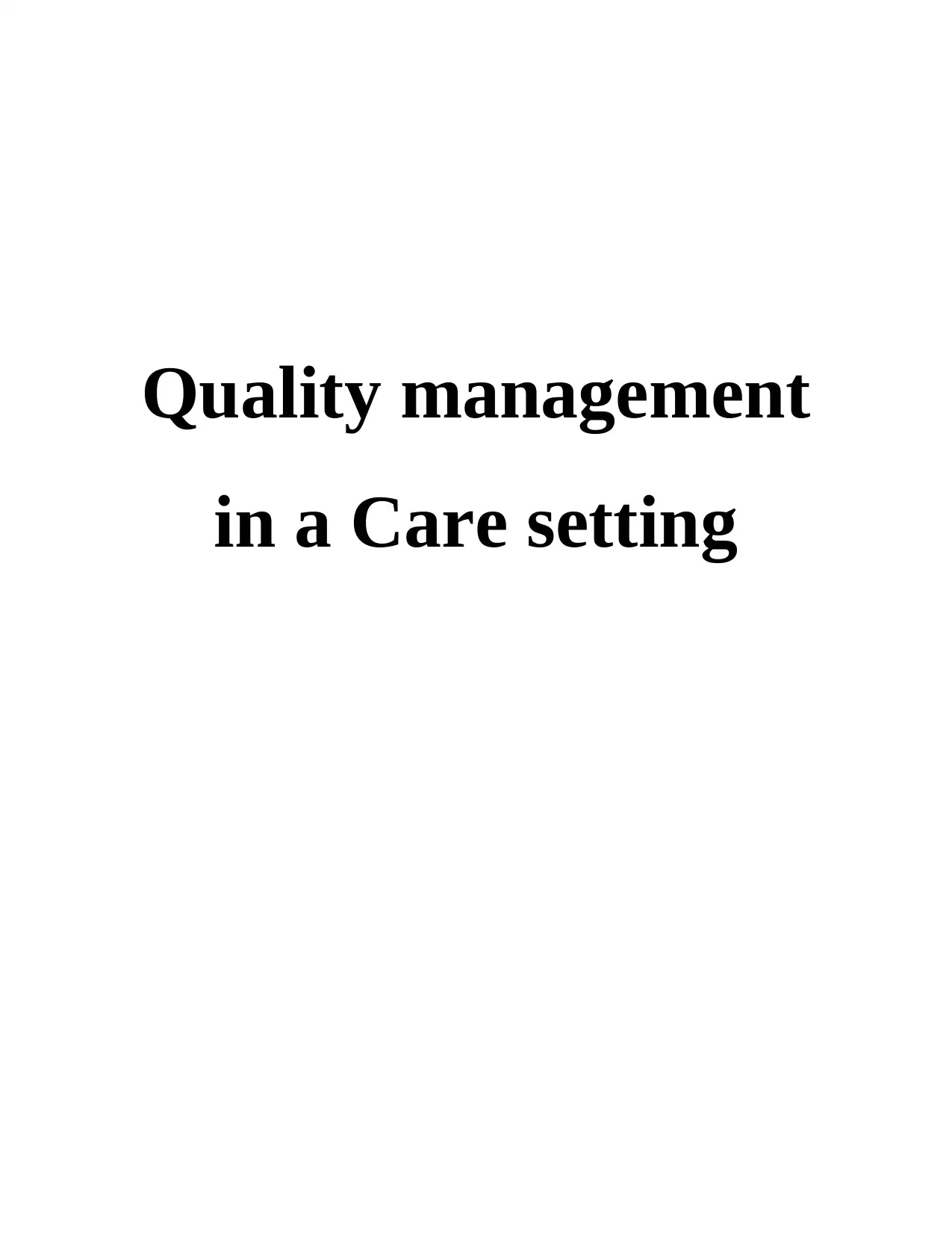
Quality management
in a Care setting
in a Care setting
Paraphrase This Document
Need a fresh take? Get an instant paraphrase of this document with our AI Paraphraser
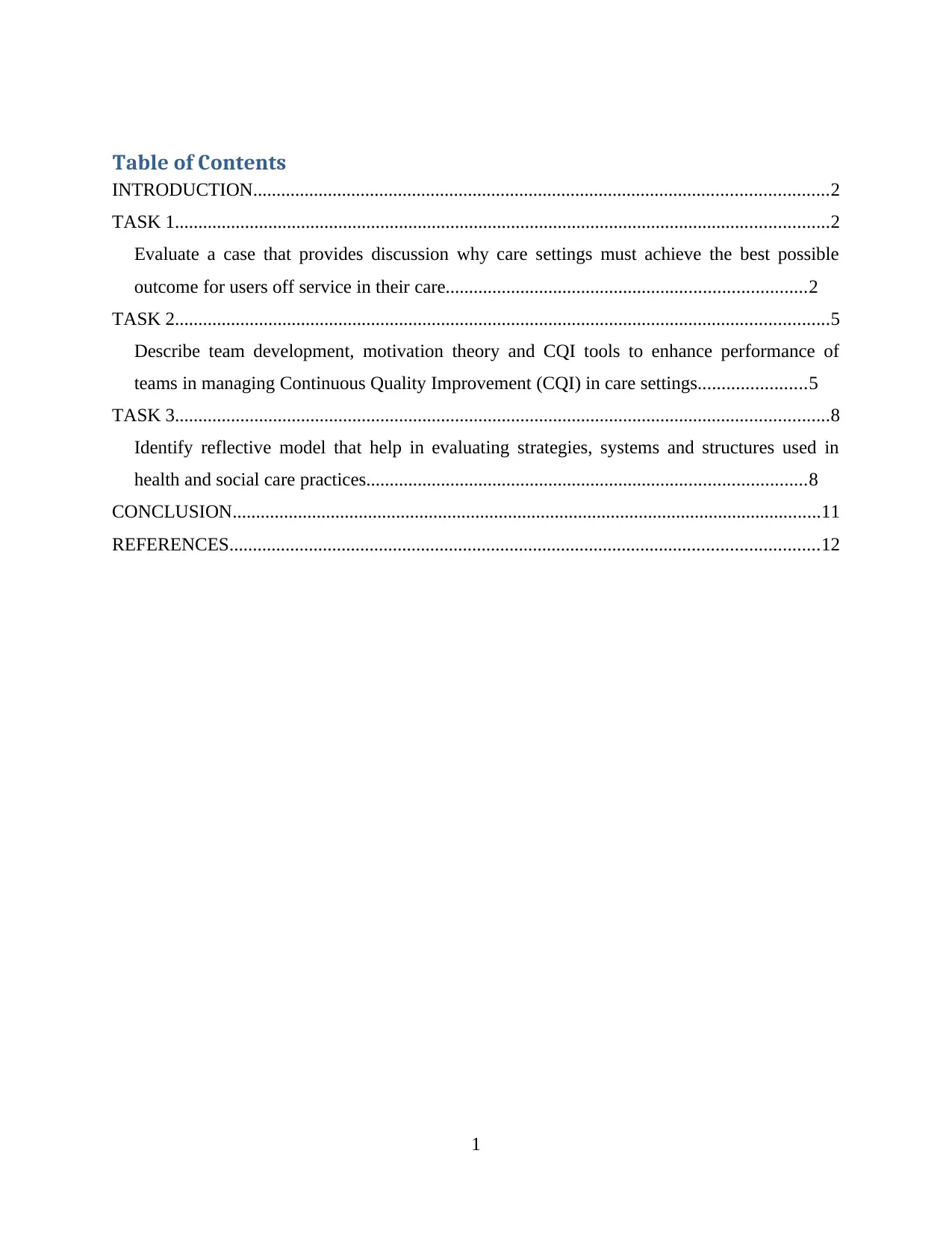
Table of Contents
INTRODUCTION...........................................................................................................................2
TASK 1............................................................................................................................................2
Evaluate a case that provides discussion why care settings must achieve the best possible
outcome for users off service in their care.............................................................................2
TASK 2............................................................................................................................................5
Describe team development, motivation theory and CQI tools to enhance performance of
teams in managing Continuous Quality Improvement (CQI) in care settings.......................5
TASK 3............................................................................................................................................8
Identify reflective model that help in evaluating strategies, systems and structures used in
health and social care practices..............................................................................................8
CONCLUSION..............................................................................................................................11
REFERENCES..............................................................................................................................12
1
INTRODUCTION...........................................................................................................................2
TASK 1............................................................................................................................................2
Evaluate a case that provides discussion why care settings must achieve the best possible
outcome for users off service in their care.............................................................................2
TASK 2............................................................................................................................................5
Describe team development, motivation theory and CQI tools to enhance performance of
teams in managing Continuous Quality Improvement (CQI) in care settings.......................5
TASK 3............................................................................................................................................8
Identify reflective model that help in evaluating strategies, systems and structures used in
health and social care practices..............................................................................................8
CONCLUSION..............................................................................................................................11
REFERENCES..............................................................................................................................12
1
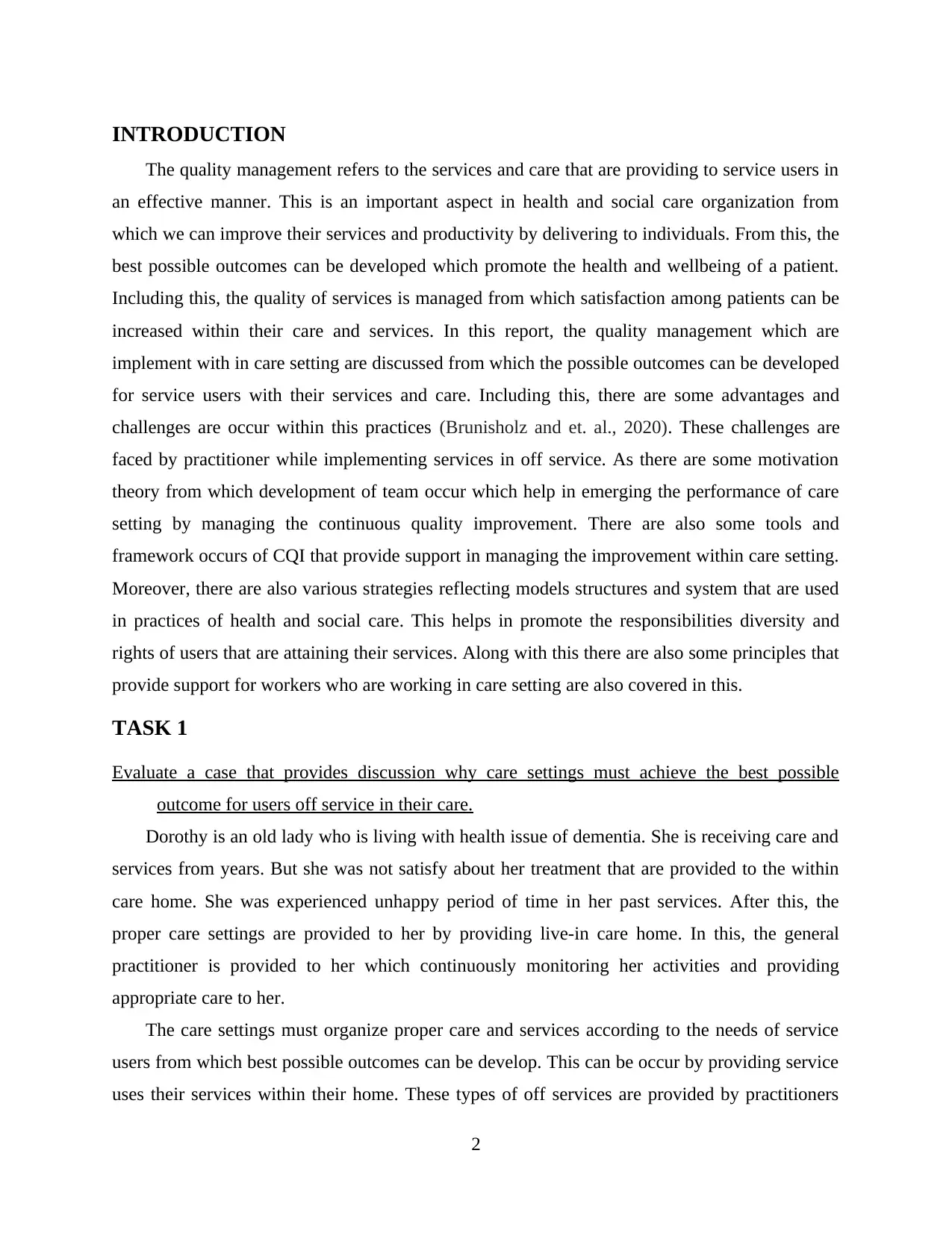
INTRODUCTION
The quality management refers to the services and care that are providing to service users in
an effective manner. This is an important aspect in health and social care organization from
which we can improve their services and productivity by delivering to individuals. From this, the
best possible outcomes can be developed which promote the health and wellbeing of a patient.
Including this, the quality of services is managed from which satisfaction among patients can be
increased within their care and services. In this report, the quality management which are
implement with in care setting are discussed from which the possible outcomes can be developed
for service users with their services and care. Including this, there are some advantages and
challenges are occur within this practices (Brunisholz and et. al., 2020). These challenges are
faced by practitioner while implementing services in off service. As there are some motivation
theory from which development of team occur which help in emerging the performance of care
setting by managing the continuous quality improvement. There are also some tools and
framework occurs of CQI that provide support in managing the improvement within care setting.
Moreover, there are also various strategies reflecting models structures and system that are used
in practices of health and social care. This helps in promote the responsibilities diversity and
rights of users that are attaining their services. Along with this there are also some principles that
provide support for workers who are working in care setting are also covered in this.
TASK 1
Evaluate a case that provides discussion why care settings must achieve the best possible
outcome for users off service in their care.
Dorothy is an old lady who is living with health issue of dementia. She is receiving care and
services from years. But she was not satisfy about her treatment that are provided to the within
care home. She was experienced unhappy period of time in her past services. After this, the
proper care settings are provided to her by providing live-in care home. In this, the general
practitioner is provided to her which continuously monitoring her activities and providing
appropriate care to her.
The care settings must organize proper care and services according to the needs of service
users from which best possible outcomes can be develop. This can be occur by providing service
uses their services within their home. These types of off services are provided by practitioners
2
The quality management refers to the services and care that are providing to service users in
an effective manner. This is an important aspect in health and social care organization from
which we can improve their services and productivity by delivering to individuals. From this, the
best possible outcomes can be developed which promote the health and wellbeing of a patient.
Including this, the quality of services is managed from which satisfaction among patients can be
increased within their care and services. In this report, the quality management which are
implement with in care setting are discussed from which the possible outcomes can be developed
for service users with their services and care. Including this, there are some advantages and
challenges are occur within this practices (Brunisholz and et. al., 2020). These challenges are
faced by practitioner while implementing services in off service. As there are some motivation
theory from which development of team occur which help in emerging the performance of care
setting by managing the continuous quality improvement. There are also some tools and
framework occurs of CQI that provide support in managing the improvement within care setting.
Moreover, there are also various strategies reflecting models structures and system that are used
in practices of health and social care. This helps in promote the responsibilities diversity and
rights of users that are attaining their services. Along with this there are also some principles that
provide support for workers who are working in care setting are also covered in this.
TASK 1
Evaluate a case that provides discussion why care settings must achieve the best possible
outcome for users off service in their care.
Dorothy is an old lady who is living with health issue of dementia. She is receiving care and
services from years. But she was not satisfy about her treatment that are provided to the within
care home. She was experienced unhappy period of time in her past services. After this, the
proper care settings are provided to her by providing live-in care home. In this, the general
practitioner is provided to her which continuously monitoring her activities and providing
appropriate care to her.
The care settings must organize proper care and services according to the needs of service
users from which best possible outcomes can be develop. This can be occur by providing service
uses their services within their home. These types of off services are provided by practitioners
2
⊘ This is a preview!⊘
Do you want full access?
Subscribe today to unlock all pages.

Trusted by 1+ million students worldwide
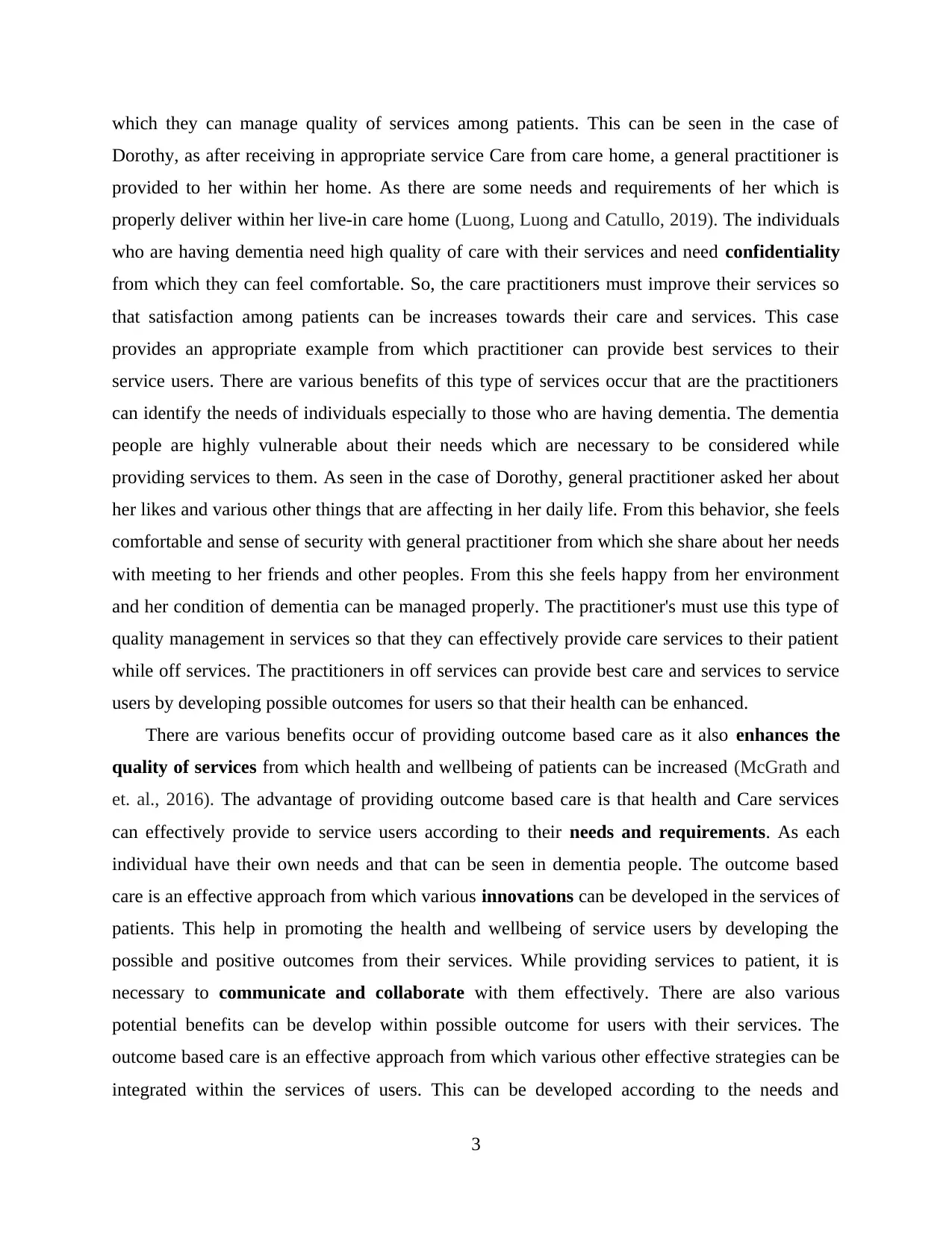
which they can manage quality of services among patients. This can be seen in the case of
Dorothy, as after receiving in appropriate service Care from care home, a general practitioner is
provided to her within her home. As there are some needs and requirements of her which is
properly deliver within her live-in care home (Luong, Luong and Catullo, 2019). The individuals
who are having dementia need high quality of care with their services and need confidentiality
from which they can feel comfortable. So, the care practitioners must improve their services so
that satisfaction among patients can be increases towards their care and services. This case
provides an appropriate example from which practitioner can provide best services to their
service users. There are various benefits of this type of services occur that are the practitioners
can identify the needs of individuals especially to those who are having dementia. The dementia
people are highly vulnerable about their needs which are necessary to be considered while
providing services to them. As seen in the case of Dorothy, general practitioner asked her about
her likes and various other things that are affecting in her daily life. From this behavior, she feels
comfortable and sense of security with general practitioner from which she share about her needs
with meeting to her friends and other peoples. From this she feels happy from her environment
and her condition of dementia can be managed properly. The practitioner's must use this type of
quality management in services so that they can effectively provide care services to their patient
while off services. The practitioners in off services can provide best care and services to service
users by developing possible outcomes for users so that their health can be enhanced.
There are various benefits occur of providing outcome based care as it also enhances the
quality of services from which health and wellbeing of patients can be increased (McGrath and
et. al., 2016). The advantage of providing outcome based care is that health and Care services
can effectively provide to service users according to their needs and requirements. As each
individual have their own needs and that can be seen in dementia people. The outcome based
care is an effective approach from which various innovations can be developed in the services of
patients. This help in promoting the health and wellbeing of service users by developing the
possible and positive outcomes from their services. While providing services to patient, it is
necessary to communicate and collaborate with them effectively. There are also various
potential benefits can be develop within possible outcome for users with their services. The
outcome based care is an effective approach from which various other effective strategies can be
integrated within the services of users. This can be developed according to the needs and
3
Dorothy, as after receiving in appropriate service Care from care home, a general practitioner is
provided to her within her home. As there are some needs and requirements of her which is
properly deliver within her live-in care home (Luong, Luong and Catullo, 2019). The individuals
who are having dementia need high quality of care with their services and need confidentiality
from which they can feel comfortable. So, the care practitioners must improve their services so
that satisfaction among patients can be increases towards their care and services. This case
provides an appropriate example from which practitioner can provide best services to their
service users. There are various benefits of this type of services occur that are the practitioners
can identify the needs of individuals especially to those who are having dementia. The dementia
people are highly vulnerable about their needs which are necessary to be considered while
providing services to them. As seen in the case of Dorothy, general practitioner asked her about
her likes and various other things that are affecting in her daily life. From this behavior, she feels
comfortable and sense of security with general practitioner from which she share about her needs
with meeting to her friends and other peoples. From this she feels happy from her environment
and her condition of dementia can be managed properly. The practitioner's must use this type of
quality management in services so that they can effectively provide care services to their patient
while off services. The practitioners in off services can provide best care and services to service
users by developing possible outcomes for users so that their health can be enhanced.
There are various benefits occur of providing outcome based care as it also enhances the
quality of services from which health and wellbeing of patients can be increased (McGrath and
et. al., 2016). The advantage of providing outcome based care is that health and Care services
can effectively provide to service users according to their needs and requirements. As each
individual have their own needs and that can be seen in dementia people. The outcome based
care is an effective approach from which various innovations can be developed in the services of
patients. This help in promoting the health and wellbeing of service users by developing the
possible and positive outcomes from their services. While providing services to patient, it is
necessary to communicate and collaborate with them effectively. There are also various
potential benefits can be develop within possible outcome for users with their services. The
outcome based care is an effective approach from which various other effective strategies can be
integrated within the services of users. This can be developed according to the needs and
3
Paraphrase This Document
Need a fresh take? Get an instant paraphrase of this document with our AI Paraphraser
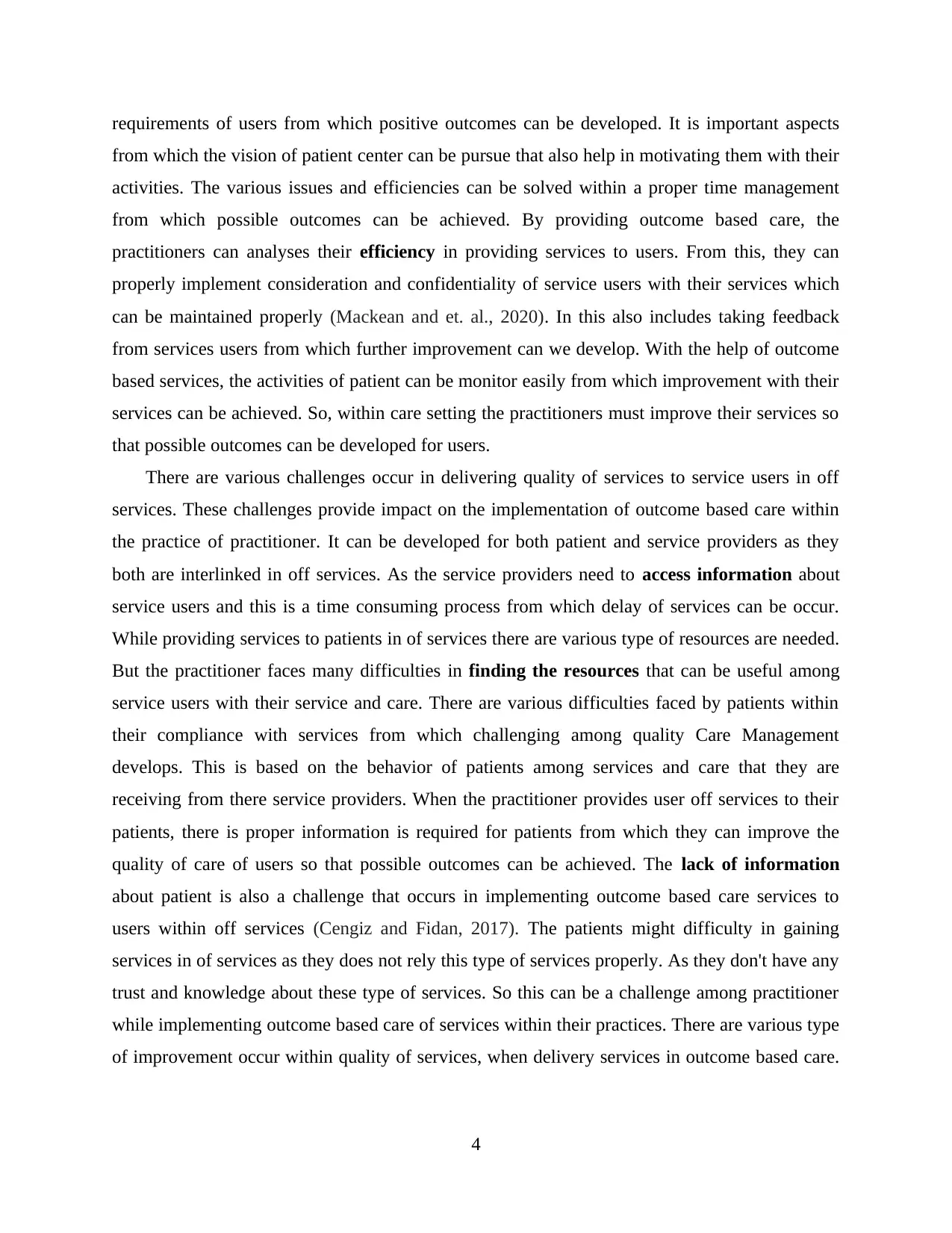
requirements of users from which positive outcomes can be developed. It is important aspects
from which the vision of patient center can be pursue that also help in motivating them with their
activities. The various issues and efficiencies can be solved within a proper time management
from which possible outcomes can be achieved. By providing outcome based care, the
practitioners can analyses their efficiency in providing services to users. From this, they can
properly implement consideration and confidentiality of service users with their services which
can be maintained properly (Mackean and et. al., 2020). In this also includes taking feedback
from services users from which further improvement can we develop. With the help of outcome
based services, the activities of patient can be monitor easily from which improvement with their
services can be achieved. So, within care setting the practitioners must improve their services so
that possible outcomes can be developed for users.
There are various challenges occur in delivering quality of services to service users in off
services. These challenges provide impact on the implementation of outcome based care within
the practice of practitioner. It can be developed for both patient and service providers as they
both are interlinked in off services. As the service providers need to access information about
service users and this is a time consuming process from which delay of services can be occur.
While providing services to patients in of services there are various type of resources are needed.
But the practitioner faces many difficulties in finding the resources that can be useful among
service users with their service and care. There are various difficulties faced by patients within
their compliance with services from which challenging among quality Care Management
develops. This is based on the behavior of patients among services and care that they are
receiving from there service providers. When the practitioner provides user off services to their
patients, there is proper information is required for patients from which they can improve the
quality of care of users so that possible outcomes can be achieved. The lack of information
about patient is also a challenge that occurs in implementing outcome based care services to
users within off services (Cengiz and Fidan, 2017). The patients might difficulty in gaining
services in of services as they does not rely this type of services properly. As they don't have any
trust and knowledge about these type of services. So this can be a challenge among practitioner
while implementing outcome based care of services within their practices. There are various type
of improvement occur within quality of services, when delivery services in outcome based care.
4
from which the vision of patient center can be pursue that also help in motivating them with their
activities. The various issues and efficiencies can be solved within a proper time management
from which possible outcomes can be achieved. By providing outcome based care, the
practitioners can analyses their efficiency in providing services to users. From this, they can
properly implement consideration and confidentiality of service users with their services which
can be maintained properly (Mackean and et. al., 2020). In this also includes taking feedback
from services users from which further improvement can we develop. With the help of outcome
based services, the activities of patient can be monitor easily from which improvement with their
services can be achieved. So, within care setting the practitioners must improve their services so
that possible outcomes can be developed for users.
There are various challenges occur in delivering quality of services to service users in off
services. These challenges provide impact on the implementation of outcome based care within
the practice of practitioner. It can be developed for both patient and service providers as they
both are interlinked in off services. As the service providers need to access information about
service users and this is a time consuming process from which delay of services can be occur.
While providing services to patients in of services there are various type of resources are needed.
But the practitioner faces many difficulties in finding the resources that can be useful among
service users with their service and care. There are various difficulties faced by patients within
their compliance with services from which challenging among quality Care Management
develops. This is based on the behavior of patients among services and care that they are
receiving from there service providers. When the practitioner provides user off services to their
patients, there is proper information is required for patients from which they can improve the
quality of care of users so that possible outcomes can be achieved. The lack of information
about patient is also a challenge that occurs in implementing outcome based care services to
users within off services (Cengiz and Fidan, 2017). The patients might difficulty in gaining
services in of services as they does not rely this type of services properly. As they don't have any
trust and knowledge about these type of services. So this can be a challenge among practitioner
while implementing outcome based care of services within their practices. There are various type
of improvement occur within quality of services, when delivery services in outcome based care.
4
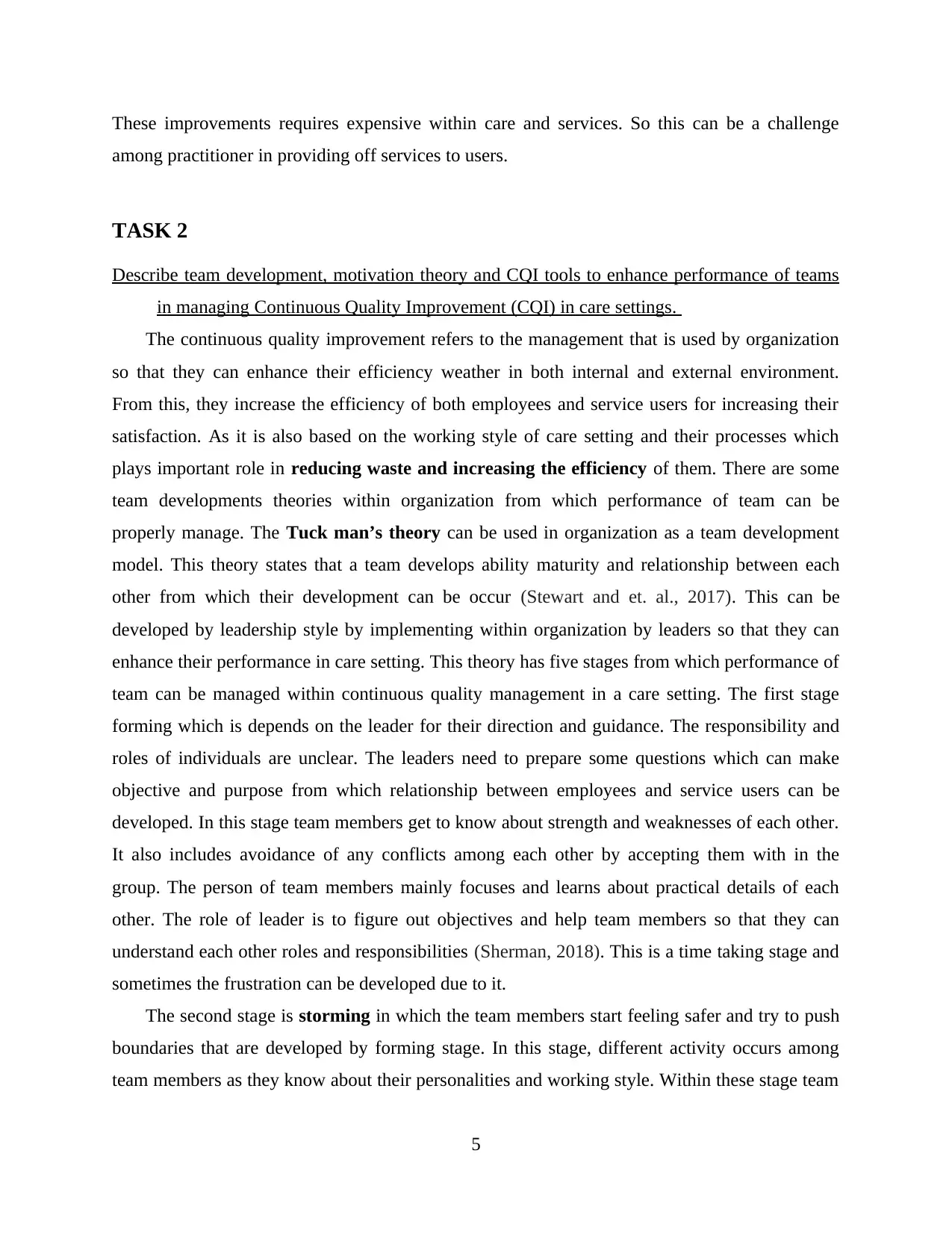
These improvements requires expensive within care and services. So this can be a challenge
among practitioner in providing off services to users.
TASK 2
Describe team development, motivation theory and CQI tools to enhance performance of teams
in managing Continuous Quality Improvement (CQI) in care settings.
The continuous quality improvement refers to the management that is used by organization
so that they can enhance their efficiency weather in both internal and external environment.
From this, they increase the efficiency of both employees and service users for increasing their
satisfaction. As it is also based on the working style of care setting and their processes which
plays important role in reducing waste and increasing the efficiency of them. There are some
team developments theories within organization from which performance of team can be
properly manage. The Tuck man’s theory can be used in organization as a team development
model. This theory states that a team develops ability maturity and relationship between each
other from which their development can be occur (Stewart and et. al., 2017). This can be
developed by leadership style by implementing within organization by leaders so that they can
enhance their performance in care setting. This theory has five stages from which performance of
team can be managed within continuous quality management in a care setting. The first stage
forming which is depends on the leader for their direction and guidance. The responsibility and
roles of individuals are unclear. The leaders need to prepare some questions which can make
objective and purpose from which relationship between employees and service users can be
developed. In this stage team members get to know about strength and weaknesses of each other.
It also includes avoidance of any conflicts among each other by accepting them with in the
group. The person of team members mainly focuses and learns about practical details of each
other. The role of leader is to figure out objectives and help team members so that they can
understand each other roles and responsibilities (Sherman, 2018). This is a time taking stage and
sometimes the frustration can be developed due to it.
The second stage is storming in which the team members start feeling safer and try to push
boundaries that are developed by forming stage. In this stage, different activity occurs among
team members as they know about their personalities and working style. Within these stage team
5
among practitioner in providing off services to users.
TASK 2
Describe team development, motivation theory and CQI tools to enhance performance of teams
in managing Continuous Quality Improvement (CQI) in care settings.
The continuous quality improvement refers to the management that is used by organization
so that they can enhance their efficiency weather in both internal and external environment.
From this, they increase the efficiency of both employees and service users for increasing their
satisfaction. As it is also based on the working style of care setting and their processes which
plays important role in reducing waste and increasing the efficiency of them. There are some
team developments theories within organization from which performance of team can be
properly manage. The Tuck man’s theory can be used in organization as a team development
model. This theory states that a team develops ability maturity and relationship between each
other from which their development can be occur (Stewart and et. al., 2017). This can be
developed by leadership style by implementing within organization by leaders so that they can
enhance their performance in care setting. This theory has five stages from which performance of
team can be managed within continuous quality management in a care setting. The first stage
forming which is depends on the leader for their direction and guidance. The responsibility and
roles of individuals are unclear. The leaders need to prepare some questions which can make
objective and purpose from which relationship between employees and service users can be
developed. In this stage team members get to know about strength and weaknesses of each other.
It also includes avoidance of any conflicts among each other by accepting them with in the
group. The person of team members mainly focuses and learns about practical details of each
other. The role of leader is to figure out objectives and help team members so that they can
understand each other roles and responsibilities (Sherman, 2018). This is a time taking stage and
sometimes the frustration can be developed due to it.
The second stage is storming in which the team members start feeling safer and try to push
boundaries that are developed by forming stage. In this stage, different activity occurs among
team members as they know about their personalities and working style. Within these stage team
5
⊘ This is a preview!⊘
Do you want full access?
Subscribe today to unlock all pages.

Trusted by 1+ million students worldwide
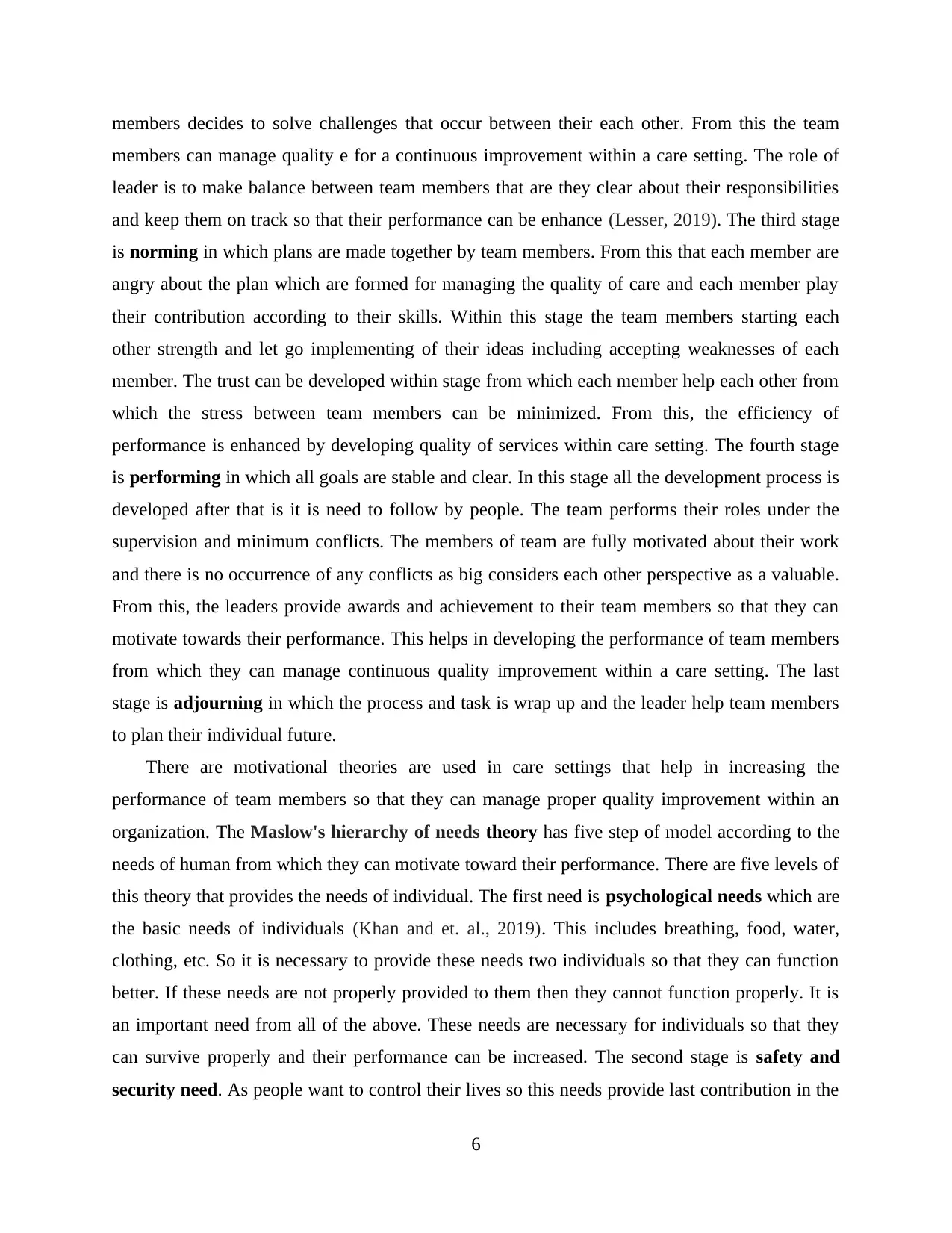
members decides to solve challenges that occur between their each other. From this the team
members can manage quality e for a continuous improvement within a care setting. The role of
leader is to make balance between team members that are they clear about their responsibilities
and keep them on track so that their performance can be enhance (Lesser, 2019). The third stage
is norming in which plans are made together by team members. From this that each member are
angry about the plan which are formed for managing the quality of care and each member play
their contribution according to their skills. Within this stage the team members starting each
other strength and let go implementing of their ideas including accepting weaknesses of each
member. The trust can be developed within stage from which each member help each other from
which the stress between team members can be minimized. From this, the efficiency of
performance is enhanced by developing quality of services within care setting. The fourth stage
is performing in which all goals are stable and clear. In this stage all the development process is
developed after that is it is need to follow by people. The team performs their roles under the
supervision and minimum conflicts. The members of team are fully motivated about their work
and there is no occurrence of any conflicts as big considers each other perspective as a valuable.
From this, the leaders provide awards and achievement to their team members so that they can
motivate towards their performance. This helps in developing the performance of team members
from which they can manage continuous quality improvement within a care setting. The last
stage is adjourning in which the process and task is wrap up and the leader help team members
to plan their individual future.
There are motivational theories are used in care settings that help in increasing the
performance of team members so that they can manage proper quality improvement within an
organization. The Maslow's hierarchy of needs theory has five step of model according to the
needs of human from which they can motivate toward their performance. There are five levels of
this theory that provides the needs of individual. The first need is psychological needs which are
the basic needs of individuals (Khan and et. al., 2019). This includes breathing, food, water,
clothing, etc. So it is necessary to provide these needs two individuals so that they can function
better. If these needs are not properly provided to them then they cannot function properly. It is
an important need from all of the above. These needs are necessary for individuals so that they
can survive properly and their performance can be increased. The second stage is safety and
security need. As people want to control their lives so this needs provide last contribution in the
6
members can manage quality e for a continuous improvement within a care setting. The role of
leader is to make balance between team members that are they clear about their responsibilities
and keep them on track so that their performance can be enhance (Lesser, 2019). The third stage
is norming in which plans are made together by team members. From this that each member are
angry about the plan which are formed for managing the quality of care and each member play
their contribution according to their skills. Within this stage the team members starting each
other strength and let go implementing of their ideas including accepting weaknesses of each
member. The trust can be developed within stage from which each member help each other from
which the stress between team members can be minimized. From this, the efficiency of
performance is enhanced by developing quality of services within care setting. The fourth stage
is performing in which all goals are stable and clear. In this stage all the development process is
developed after that is it is need to follow by people. The team performs their roles under the
supervision and minimum conflicts. The members of team are fully motivated about their work
and there is no occurrence of any conflicts as big considers each other perspective as a valuable.
From this, the leaders provide awards and achievement to their team members so that they can
motivate towards their performance. This helps in developing the performance of team members
from which they can manage continuous quality improvement within a care setting. The last
stage is adjourning in which the process and task is wrap up and the leader help team members
to plan their individual future.
There are motivational theories are used in care settings that help in increasing the
performance of team members so that they can manage proper quality improvement within an
organization. The Maslow's hierarchy of needs theory has five step of model according to the
needs of human from which they can motivate toward their performance. There are five levels of
this theory that provides the needs of individual. The first need is psychological needs which are
the basic needs of individuals (Khan and et. al., 2019). This includes breathing, food, water,
clothing, etc. So it is necessary to provide these needs two individuals so that they can function
better. If these needs are not properly provided to them then they cannot function properly. It is
an important need from all of the above. These needs are necessary for individuals so that they
can survive properly and their performance can be increased. The second stage is safety and
security need. As people want to control their lives so this needs provide last contribution in the
6
Paraphrase This Document
Need a fresh take? Get an instant paraphrase of this document with our AI Paraphraser
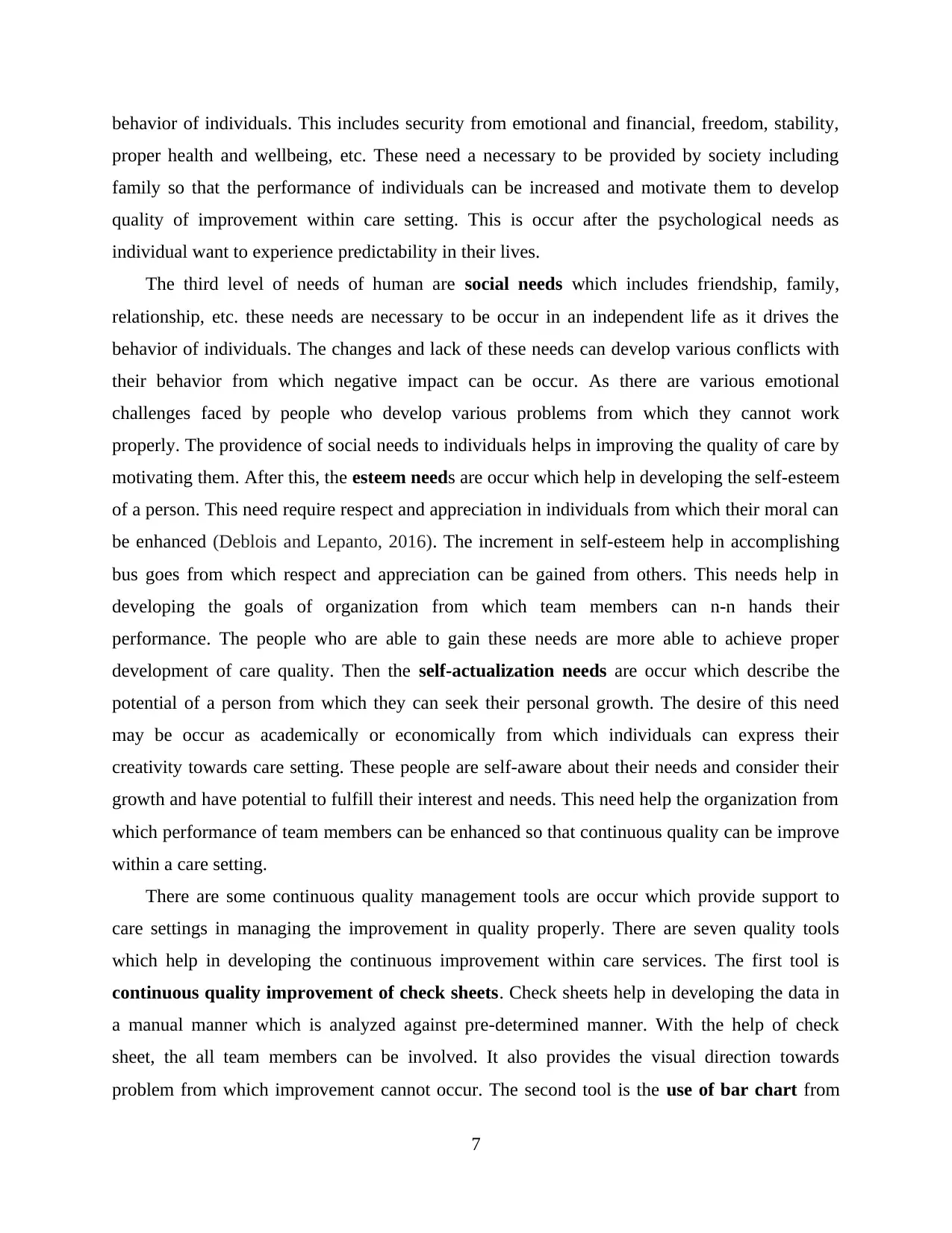
behavior of individuals. This includes security from emotional and financial, freedom, stability,
proper health and wellbeing, etc. These need a necessary to be provided by society including
family so that the performance of individuals can be increased and motivate them to develop
quality of improvement within care setting. This is occur after the psychological needs as
individual want to experience predictability in their lives.
The third level of needs of human are social needs which includes friendship, family,
relationship, etc. these needs are necessary to be occur in an independent life as it drives the
behavior of individuals. The changes and lack of these needs can develop various conflicts with
their behavior from which negative impact can be occur. As there are various emotional
challenges faced by people who develop various problems from which they cannot work
properly. The providence of social needs to individuals helps in improving the quality of care by
motivating them. After this, the esteem needs are occur which help in developing the self-esteem
of a person. This need require respect and appreciation in individuals from which their moral can
be enhanced (Deblois and Lepanto, 2016). The increment in self-esteem help in accomplishing
bus goes from which respect and appreciation can be gained from others. This needs help in
developing the goals of organization from which team members can n-n hands their
performance. The people who are able to gain these needs are more able to achieve proper
development of care quality. Then the self-actualization needs are occur which describe the
potential of a person from which they can seek their personal growth. The desire of this need
may be occur as academically or economically from which individuals can express their
creativity towards care setting. These people are self-aware about their needs and consider their
growth and have potential to fulfill their interest and needs. This need help the organization from
which performance of team members can be enhanced so that continuous quality can be improve
within a care setting.
There are some continuous quality management tools are occur which provide support to
care settings in managing the improvement in quality properly. There are seven quality tools
which help in developing the continuous improvement within care services. The first tool is
continuous quality improvement of check sheets. Check sheets help in developing the data in
a manual manner which is analyzed against pre-determined manner. With the help of check
sheet, the all team members can be involved. It also provides the visual direction towards
problem from which improvement cannot occur. The second tool is the use of bar chart from
7
proper health and wellbeing, etc. These need a necessary to be provided by society including
family so that the performance of individuals can be increased and motivate them to develop
quality of improvement within care setting. This is occur after the psychological needs as
individual want to experience predictability in their lives.
The third level of needs of human are social needs which includes friendship, family,
relationship, etc. these needs are necessary to be occur in an independent life as it drives the
behavior of individuals. The changes and lack of these needs can develop various conflicts with
their behavior from which negative impact can be occur. As there are various emotional
challenges faced by people who develop various problems from which they cannot work
properly. The providence of social needs to individuals helps in improving the quality of care by
motivating them. After this, the esteem needs are occur which help in developing the self-esteem
of a person. This need require respect and appreciation in individuals from which their moral can
be enhanced (Deblois and Lepanto, 2016). The increment in self-esteem help in accomplishing
bus goes from which respect and appreciation can be gained from others. This needs help in
developing the goals of organization from which team members can n-n hands their
performance. The people who are able to gain these needs are more able to achieve proper
development of care quality. Then the self-actualization needs are occur which describe the
potential of a person from which they can seek their personal growth. The desire of this need
may be occur as academically or economically from which individuals can express their
creativity towards care setting. These people are self-aware about their needs and consider their
growth and have potential to fulfill their interest and needs. This need help the organization from
which performance of team members can be enhanced so that continuous quality can be improve
within a care setting.
There are some continuous quality management tools are occur which provide support to
care settings in managing the improvement in quality properly. There are seven quality tools
which help in developing the continuous improvement within care services. The first tool is
continuous quality improvement of check sheets. Check sheets help in developing the data in
a manual manner which is analyzed against pre-determined manner. With the help of check
sheet, the all team members can be involved. It also provides the visual direction towards
problem from which improvement cannot occur. The second tool is the use of bar chart from
7
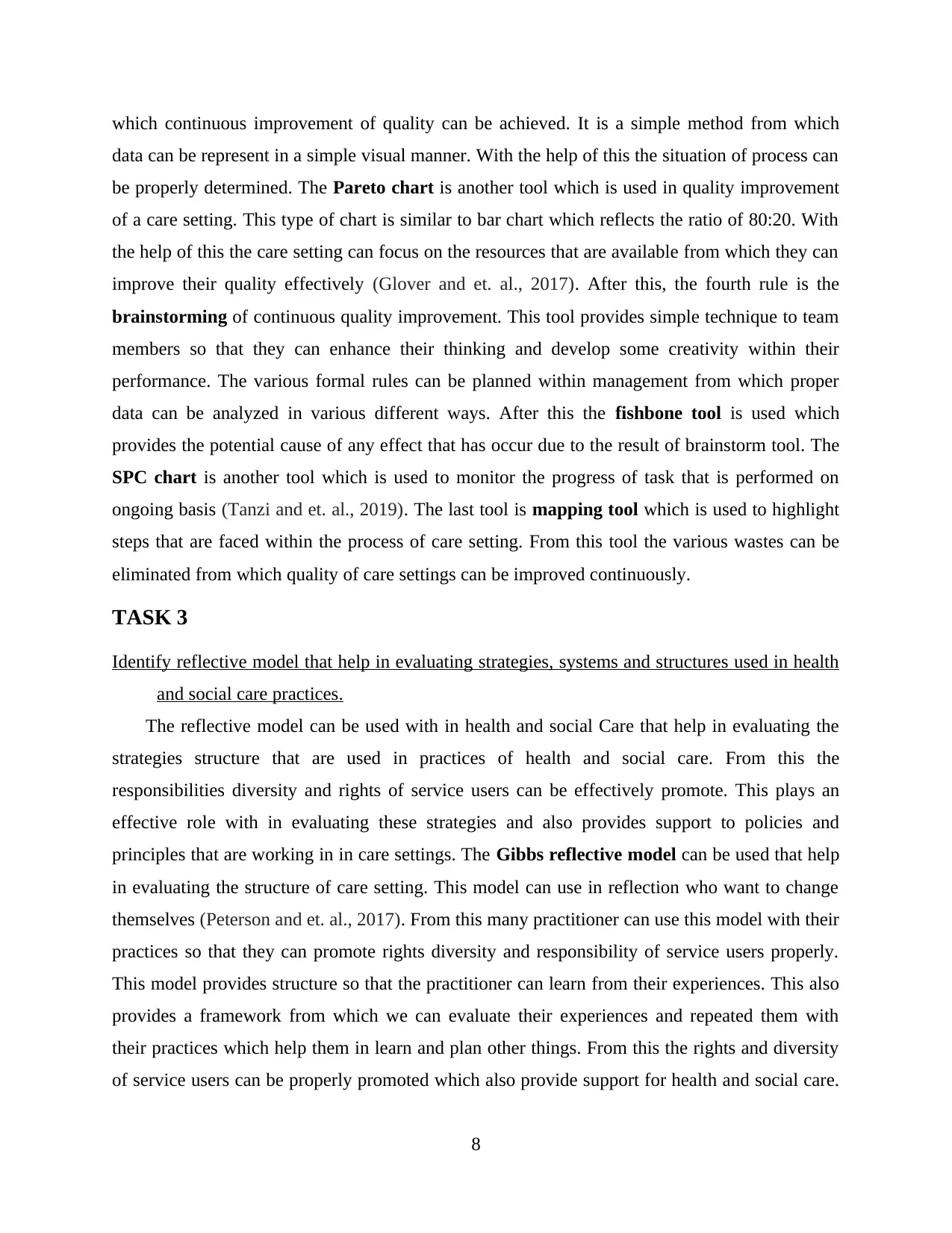
which continuous improvement of quality can be achieved. It is a simple method from which
data can be represent in a simple visual manner. With the help of this the situation of process can
be properly determined. The Pareto chart is another tool which is used in quality improvement
of a care setting. This type of chart is similar to bar chart which reflects the ratio of 80:20. With
the help of this the care setting can focus on the resources that are available from which they can
improve their quality effectively (Glover and et. al., 2017). After this, the fourth rule is the
brainstorming of continuous quality improvement. This tool provides simple technique to team
members so that they can enhance their thinking and develop some creativity within their
performance. The various formal rules can be planned within management from which proper
data can be analyzed in various different ways. After this the fishbone tool is used which
provides the potential cause of any effect that has occur due to the result of brainstorm tool. The
SPC chart is another tool which is used to monitor the progress of task that is performed on
ongoing basis (Tanzi and et. al., 2019). The last tool is mapping tool which is used to highlight
steps that are faced within the process of care setting. From this tool the various wastes can be
eliminated from which quality of care settings can be improved continuously.
TASK 3
Identify reflective model that help in evaluating strategies, systems and structures used in health
and social care practices.
The reflective model can be used with in health and social Care that help in evaluating the
strategies structure that are used in practices of health and social care. From this the
responsibilities diversity and rights of service users can be effectively promote. This plays an
effective role with in evaluating these strategies and also provides support to policies and
principles that are working in in care settings. The Gibbs reflective model can be used that help
in evaluating the structure of care setting. This model can use in reflection who want to change
themselves (Peterson and et. al., 2017). From this many practitioner can use this model with their
practices so that they can promote rights diversity and responsibility of service users properly.
This model provides structure so that the practitioner can learn from their experiences. This also
provides a framework from which we can evaluate their experiences and repeated them with
their practices which help them in learn and plan other things. From this the rights and diversity
of service users can be properly promoted which also provide support for health and social care.
8
data can be represent in a simple visual manner. With the help of this the situation of process can
be properly determined. The Pareto chart is another tool which is used in quality improvement
of a care setting. This type of chart is similar to bar chart which reflects the ratio of 80:20. With
the help of this the care setting can focus on the resources that are available from which they can
improve their quality effectively (Glover and et. al., 2017). After this, the fourth rule is the
brainstorming of continuous quality improvement. This tool provides simple technique to team
members so that they can enhance their thinking and develop some creativity within their
performance. The various formal rules can be planned within management from which proper
data can be analyzed in various different ways. After this the fishbone tool is used which
provides the potential cause of any effect that has occur due to the result of brainstorm tool. The
SPC chart is another tool which is used to monitor the progress of task that is performed on
ongoing basis (Tanzi and et. al., 2019). The last tool is mapping tool which is used to highlight
steps that are faced within the process of care setting. From this tool the various wastes can be
eliminated from which quality of care settings can be improved continuously.
TASK 3
Identify reflective model that help in evaluating strategies, systems and structures used in health
and social care practices.
The reflective model can be used with in health and social Care that help in evaluating the
strategies structure that are used in practices of health and social care. From this the
responsibilities diversity and rights of service users can be effectively promote. This plays an
effective role with in evaluating these strategies and also provides support to policies and
principles that are working in in care settings. The Gibbs reflective model can be used that help
in evaluating the structure of care setting. This model can use in reflection who want to change
themselves (Peterson and et. al., 2017). From this many practitioner can use this model with their
practices so that they can promote rights diversity and responsibility of service users properly.
This model provides structure so that the practitioner can learn from their experiences. This also
provides a framework from which we can evaluate their experiences and repeated them with
their practices which help them in learn and plan other things. From this the rights and diversity
of service users can be properly promoted which also provide support for health and social care.
8
⊘ This is a preview!⊘
Do you want full access?
Subscribe today to unlock all pages.

Trusted by 1+ million students worldwide
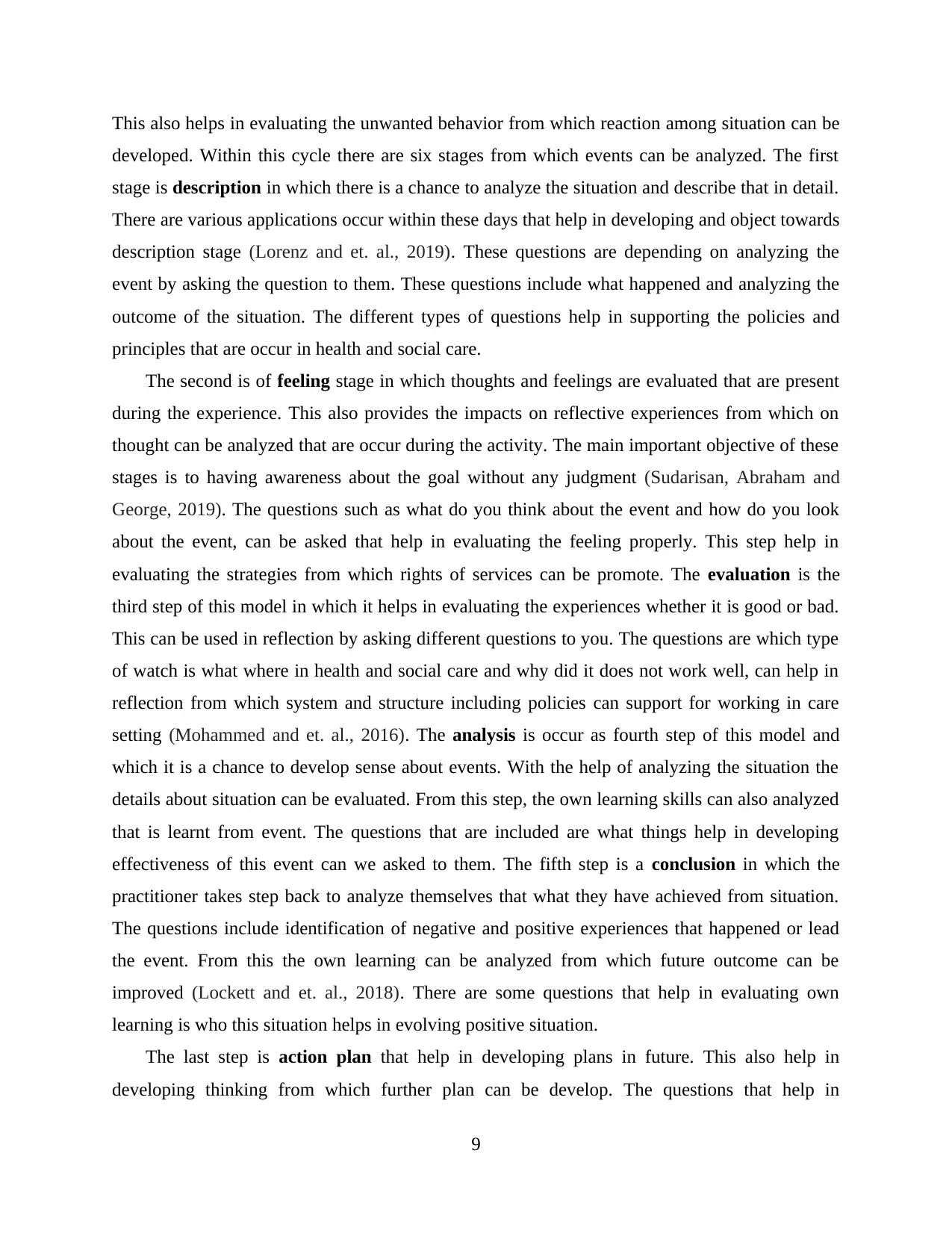
This also helps in evaluating the unwanted behavior from which reaction among situation can be
developed. Within this cycle there are six stages from which events can be analyzed. The first
stage is description in which there is a chance to analyze the situation and describe that in detail.
There are various applications occur within these days that help in developing and object towards
description stage (Lorenz and et. al., 2019). These questions are depending on analyzing the
event by asking the question to them. These questions include what happened and analyzing the
outcome of the situation. The different types of questions help in supporting the policies and
principles that are occur in health and social care.
The second is of feeling stage in which thoughts and feelings are evaluated that are present
during the experience. This also provides the impacts on reflective experiences from which on
thought can be analyzed that are occur during the activity. The main important objective of these
stages is to having awareness about the goal without any judgment (Sudarisan, Abraham and
George, 2019). The questions such as what do you think about the event and how do you look
about the event, can be asked that help in evaluating the feeling properly. This step help in
evaluating the strategies from which rights of services can be promote. The evaluation is the
third step of this model in which it helps in evaluating the experiences whether it is good or bad.
This can be used in reflection by asking different questions to you. The questions are which type
of watch is what where in health and social care and why did it does not work well, can help in
reflection from which system and structure including policies can support for working in care
setting (Mohammed and et. al., 2016). The analysis is occur as fourth step of this model and
which it is a chance to develop sense about events. With the help of analyzing the situation the
details about situation can be evaluated. From this step, the own learning skills can also analyzed
that is learnt from event. The questions that are included are what things help in developing
effectiveness of this event can we asked to them. The fifth step is a conclusion in which the
practitioner takes step back to analyze themselves that what they have achieved from situation.
The questions include identification of negative and positive experiences that happened or lead
the event. From this the own learning can be analyzed from which future outcome can be
improved (Lockett and et. al., 2018). There are some questions that help in evaluating own
learning is who this situation helps in evolving positive situation.
The last step is action plan that help in developing plans in future. This also help in
developing thinking from which further plan can be develop. The questions that help in
9
developed. Within this cycle there are six stages from which events can be analyzed. The first
stage is description in which there is a chance to analyze the situation and describe that in detail.
There are various applications occur within these days that help in developing and object towards
description stage (Lorenz and et. al., 2019). These questions are depending on analyzing the
event by asking the question to them. These questions include what happened and analyzing the
outcome of the situation. The different types of questions help in supporting the policies and
principles that are occur in health and social care.
The second is of feeling stage in which thoughts and feelings are evaluated that are present
during the experience. This also provides the impacts on reflective experiences from which on
thought can be analyzed that are occur during the activity. The main important objective of these
stages is to having awareness about the goal without any judgment (Sudarisan, Abraham and
George, 2019). The questions such as what do you think about the event and how do you look
about the event, can be asked that help in evaluating the feeling properly. This step help in
evaluating the strategies from which rights of services can be promote. The evaluation is the
third step of this model in which it helps in evaluating the experiences whether it is good or bad.
This can be used in reflection by asking different questions to you. The questions are which type
of watch is what where in health and social care and why did it does not work well, can help in
reflection from which system and structure including policies can support for working in care
setting (Mohammed and et. al., 2016). The analysis is occur as fourth step of this model and
which it is a chance to develop sense about events. With the help of analyzing the situation the
details about situation can be evaluated. From this step, the own learning skills can also analyzed
that is learnt from event. The questions that are included are what things help in developing
effectiveness of this event can we asked to them. The fifth step is a conclusion in which the
practitioner takes step back to analyze themselves that what they have achieved from situation.
The questions include identification of negative and positive experiences that happened or lead
the event. From this the own learning can be analyzed from which future outcome can be
improved (Lockett and et. al., 2018). There are some questions that help in evaluating own
learning is who this situation helps in evolving positive situation.
The last step is action plan that help in developing plans in future. This also help in
developing thinking from which further plan can be develop. The questions that help in
9
Paraphrase This Document
Need a fresh take? Get an instant paraphrase of this document with our AI Paraphraser
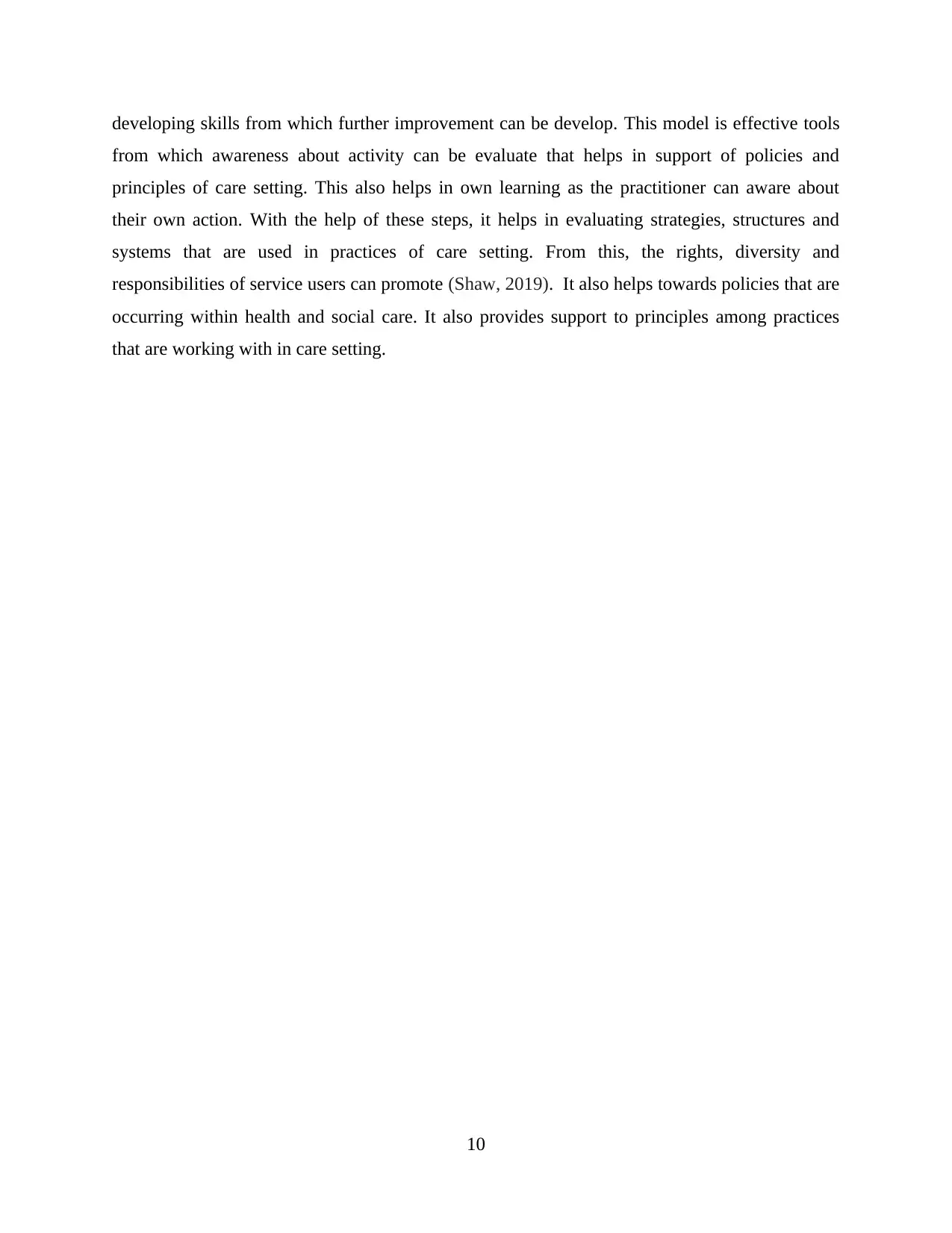
developing skills from which further improvement can be develop. This model is effective tools
from which awareness about activity can be evaluate that helps in support of policies and
principles of care setting. This also helps in own learning as the practitioner can aware about
their own action. With the help of these steps, it helps in evaluating strategies, structures and
systems that are used in practices of care setting. From this, the rights, diversity and
responsibilities of service users can promote (Shaw, 2019). It also helps towards policies that are
occurring within health and social care. It also provides support to principles among practices
that are working with in care setting.
10
from which awareness about activity can be evaluate that helps in support of policies and
principles of care setting. This also helps in own learning as the practitioner can aware about
their own action. With the help of these steps, it helps in evaluating strategies, structures and
systems that are used in practices of care setting. From this, the rights, diversity and
responsibilities of service users can promote (Shaw, 2019). It also helps towards policies that are
occurring within health and social care. It also provides support to principles among practices
that are working with in care setting.
10
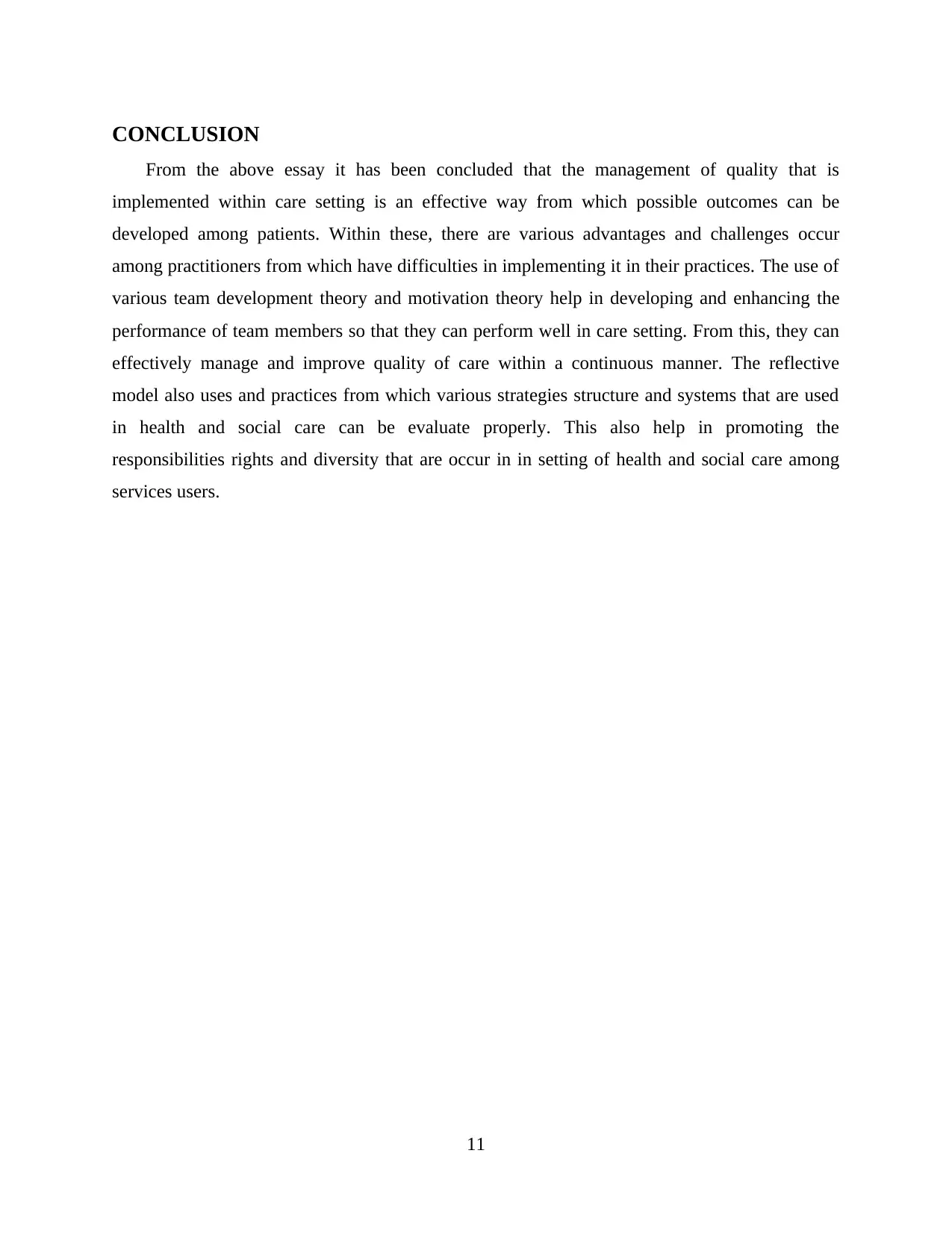
CONCLUSION
From the above essay it has been concluded that the management of quality that is
implemented within care setting is an effective way from which possible outcomes can be
developed among patients. Within these, there are various advantages and challenges occur
among practitioners from which have difficulties in implementing it in their practices. The use of
various team development theory and motivation theory help in developing and enhancing the
performance of team members so that they can perform well in care setting. From this, they can
effectively manage and improve quality of care within a continuous manner. The reflective
model also uses and practices from which various strategies structure and systems that are used
in health and social care can be evaluate properly. This also help in promoting the
responsibilities rights and diversity that are occur in in setting of health and social care among
services users.
11
From the above essay it has been concluded that the management of quality that is
implemented within care setting is an effective way from which possible outcomes can be
developed among patients. Within these, there are various advantages and challenges occur
among practitioners from which have difficulties in implementing it in their practices. The use of
various team development theory and motivation theory help in developing and enhancing the
performance of team members so that they can perform well in care setting. From this, they can
effectively manage and improve quality of care within a continuous manner. The reflective
model also uses and practices from which various strategies structure and systems that are used
in health and social care can be evaluate properly. This also help in promoting the
responsibilities rights and diversity that are occur in in setting of health and social care among
services users.
11
⊘ This is a preview!⊘
Do you want full access?
Subscribe today to unlock all pages.

Trusted by 1+ million students worldwide
1 out of 14
Related Documents
Your All-in-One AI-Powered Toolkit for Academic Success.
+13062052269
info@desklib.com
Available 24*7 on WhatsApp / Email
![[object Object]](/_next/static/media/star-bottom.7253800d.svg)
Unlock your academic potential
Copyright © 2020–2025 A2Z Services. All Rights Reserved. Developed and managed by ZUCOL.





